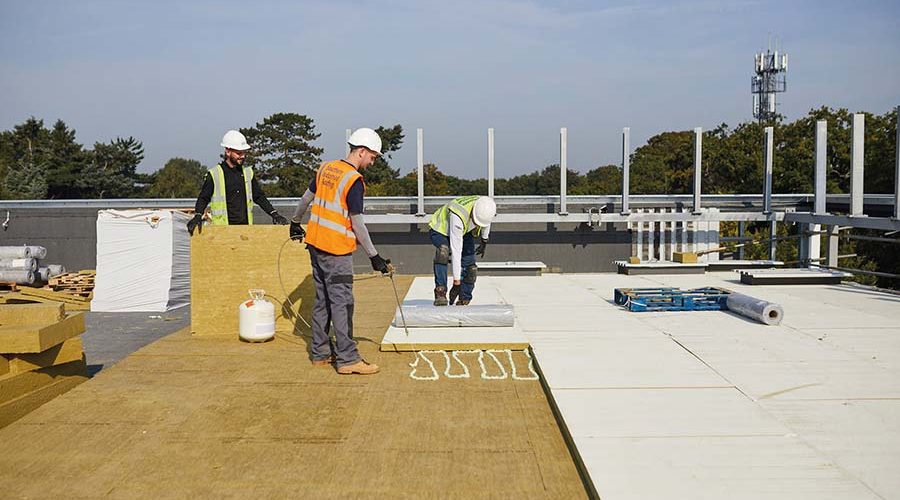Arson accounts for 50.5% of fire service call-outs in the UK, making it the most common cause of fire in the country. Due to ease of access, this is a notable concern for all buildings with flat roofs, particularly schools. Discussing the wider socio-economic impact of roof fires in education buildings, Will Wigfield, Product Manager for Flat Roof at ROCKWOOL UK, examines how these risks can be mitigated.
ROCKWOOL
While flat roofs remain a popular design choice in education buildings, they are not without their risks. If a fire was to take hold in the roof, there is a significant risk that the building could collapse. Moreover, the consequences of this extend far beyond the financial cost of repair.
When designing education buildings, fire protection is a primary concern. With a staggering 40 fire incidents occurring in schools each month, ensuring a building is safeguarded to perform in the event of a fire is essential.
Focusing attention on the roof, its role has evolved far beyond the traditional purpose of keeping a building watertight. For example, flat roofs are commonly used to house mechanical and electrical (M&E) equipment, failure of which can lead to a roof fire. With solar panels specifically, there are known incidences of faults causing fires by ‘arcing’.
Maintenance and refurbishment works on flat roofs can also present a fire hazard. Grinding, welding and torch-applied roofing are all hot works that can cause a fire to ignite.
Regardless of the cause of a fire, if it takes hold in the roof of a school building, the damage of this would be felt far beyond financial detriment.
The wider socio-economic impact
If a school is closed due to fire damage, it causes significant disruption as teaching and learning are moved to alternative schools or temporary buildings. While these emergency arrangements are in place, students are at risk of significant learning loss, staff are displaced and parents have to navigate unsettled routines. Such scenarios also place increased strain on the resources of nearby schools.
In order to avoid such unrest, one aspect of best practice is to consider the roof build-up, introducing measures that will help maintain its structure even if a fire was to take hold. A crucial part of this is the role of insulation in flat roof design.
Not all insulation is the same
Insulation is primarily installed to reduce heat loss in education buildings, ensuring the optimum temperature is maintained to support a comfortable learning environment and reduce energy costs. However, for school environments, insulation has a much wider role to play, and by using non-combustible stone wool insulation, the full range of performance criteria can be addressed with a single specification.
For example, beyond thermal, flat roofs in schools must also comply with BB93, which specifies maximum levels of rain noise transfer. While a separate barrier mat can be used to achieve the necessary sound reduction, it introduces a costly additional layer into the roof build-up. Where stone wool insulation is specified, sound reduction is inherent in the material which often removes the need for a separate acoustic layer.
Furthermore, flat roofs have a pivotal role to play in fire protection, whether that is to provide safe access for roof maintenance, ensure safe passage of exit in the event of fire, or secure effective compartmentation with the internal walls below.
Although flat roofs can be designed with ‘zones’ that detail where non-combustible insulation must be used, this can create coordination challenges on site. Given stone wool can simplify the roof build-up by providing proven thermal and acoustic properties in one product, best practice is to apply this non-combustible material across the full roof area – a design strategy that was recently undertaken by Southern Industrial Roofing at Cobham Free School in Surrey.
A lesson in minimising risk
In addition to regulation compliance, rooftop plant and compartmentation in the internal walls below created a complex design challenge at Cobham Free School.
By using ROCKWOOL stone wool products to insulate the warm flat roof, Southern Industrial Roofing simplified overall design, achieved onsite efficiency gains and increased confidence in the performance of the system build-up.
“Using a single insulation product greatly streamlined the whole process for us. Not just design, but installation too. We didn’t have to worry about coordinating zones with different materials – it was ROCKWOOL across the board which simultaneously delivered the acoustic, fire and thermal performance we needed,” explained Andy Towns, Designer at Southern Industrial Roofing.










